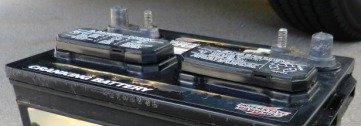Battery Construction Types
Learn about the different basic battery construction types which will help you select the most optimum battery for your application. Each construction type offers certain advantages - length of service, ease of maintenance, maintenance free and more.
3 Battery Construction Types
- Wet Cell Battery
- Gel Battery
- AGM Battery
Wet Cell Batteries
Wet cell batteries used for starting/cranking and deep cycle are very common. These can be recognized easily by the removeable caps on the top of the battery.

The six wet cells contain lead, lead oxide and a sulfuric acid solution. A chemical reaction occurs when an electrical device is connected to the terminals and is turned on. This chemical reaction is reversed during the recharging process and the battery is available for full usage time after time. Periodic checking that each cell is filled with water is important for the life of the battery. It is important that these batteries be kept upright so that this solution will not spill. Also care must be taken when servicing these batteries because this sulfuric acid solution can burn skin and leave holes in clothing should the solution come in contact with drops or spills.
Gel Batteries
Gel cell batteries contain a silica gel that the battery electrolyte is suspended in. This gel is like a thick paste like material and allows electrons to flow between plates. Two advantages to the gel cell battery is that it will not leak from the battery if the case is broken. Secondly, the gel cell battery works well when slow discharge rates are needed. Disadvantages include a higher cost than wet cell batteries and the method of charging is critical - if done incorrectly the battery will fail long before it should. The battery charger must be made or designed for gel cell batteries. If used as a starter battery and your motor has an alternator it must be fitted with a special regulator.
AGM - Absorbed Glass Material
AGM batteries use a silicon glass fiber placed between the lead plates in the cells. This makes the AGM battery is spill proof like the gel cell. The AGM battery can also use a standard batter charger to be recharged. In addition, the AGM battery may be the best battery to use in situations where it must sit unused for longer periods of time because its self discharge rate tends to be much less. The biggest disadvantage to both gel cell and AGM batteries are their cost which tends to be on the higher end.

Each of these battery types offer specific advantages and will start your motor, and/or power your accessories. Factors to consider are your budget, how often you use your boat and how much power you will need for your accessories. Find a battery wholesaler - we use the local Interstate company.
We are an Amazon Affiliate. If you purchase a product we recommend or another product while on Amazon, we may receive a small commission. Our staff recommends items that we have personally owned, used/tested, researched or we have fished with trusted anglers who recommend them. These products will not cost you any more than what is posted.